
Бесплатный фрагмент - Alma-Ata — discouraging charm in the Centre of Asia
The subjective guidebook
From the author: An extraordinary city
“First time I saw this extraordinary city, so unlike any city of the world, in 1933, and I remember how much it surprised me”. This is the first line of the most Alma-Atinian novel of all novels in the literature of the world, titled “The Keeper of Antiquities’ and written by Yuri Dombrovsky. The novel where Alma-Ata became one of the central characters.
Now, there is almost nothing left of the city of 1930s that was described by the well-known author. Apart from that still strikingly beautiful orthodox cathedral in the heart of the city, and a few pre-revolutionary buildings, changed beyond recognition by modern renovators. But it is just outwardly. The essence of the city and its wonderful atmosphere remained unchanged. And even became more refined. Just this phenomenon: the spirited look of the streets, humane rhythm of life, extraordinarily outgoing personalities of its residents, all in all creates this at once recognizable aura, which makes our city outstanding among hundreds of others with millions of people populations.
Long ago I paid attention to the fact how tangible this aura is at various art exhibitions. You are roaming around these cold and balanced canvases and suddenly, the wave of some life-giving warmth is incoming from somewhere, and warms up your soul and set your brain, distorted with different -isms, right. Look, but this is my Alma-Ata here, in frame! Like a kind-hearted and caring woman selling her pies just next to impersonal sushi-bars and McDonalds.
They say that the spot where our city stands has some abnormal properties. Not without reason it is loved so much by various mentalists, magicians, transcendent experimenters, and alternative medicine adepts. For the example they take the Aporte apple story: in its homeland it was an ordinary sour stuff, and once it got here, it turned into a king-apple, the city symbol, and the participant of international trade shows. (What a shame that after apple orchards had been cut in recent decades for the sake of house construction, the famous Aporte remained rather in memories than de facto…)
As another example, I would draw your attention to our women’s beauty phenomenon: just within one generation they have managed to gain the lead among the acknowledged beauties of the world. Isn’t it a miracle?
And they also assert that the city is built according to all the feng shui canons. But it is doubtable, because Major Peremyshlskiy who laid the foundation of the fortress Vernyi in 1854 had hardly heard about these feng shuis: despite his literacy, he was quite a reasonable person. Not devoid of some insight, though.
Initially, the construction of the city-fortress in the land of Zailiyskiy Alatau, the outpost of the Russian empire on new boundaries, had been planned further east, at the place of today’s Issyk. But after the hard over-wintering this variant was discarded and it was decided to make further searches. And they did find the right place. With feng shui, or without feng shui — anyway, the city, even a great deal expanded, is located in the exquisitely cozy place. It is like a silk carpet: it slowly flows down the highest ice-covered peak onto the hot steppe, extending into vastness.
Maybe just in its position, on such an evident border of powers: the greatest mountains (up to the very Indian ocean) and the greatest plains (up to the Arctic ocean), should we seek for the deep secret of Alma-Ata’s charm? Because, if we try to understand, all the most interesting and intensive processes on Earth happen just on such borders. When something (or somebody), deriving strength from these opposite powers, moves along the thin line of the Median way. Especially that the geographic factor overlapped with the ethnic factor: the population of the city is half Asian, half European.
…I saw this unusual city for the first time in 1958. It was my birthday. And I realized that it is really different from any other city of the world later, after I visited and roamed many cities of this another world. Among them there is a dozen of such cities that I love very much. But nowhere else I feel so peaceful and happy like I do at home. In my sweet Alma-Ata.
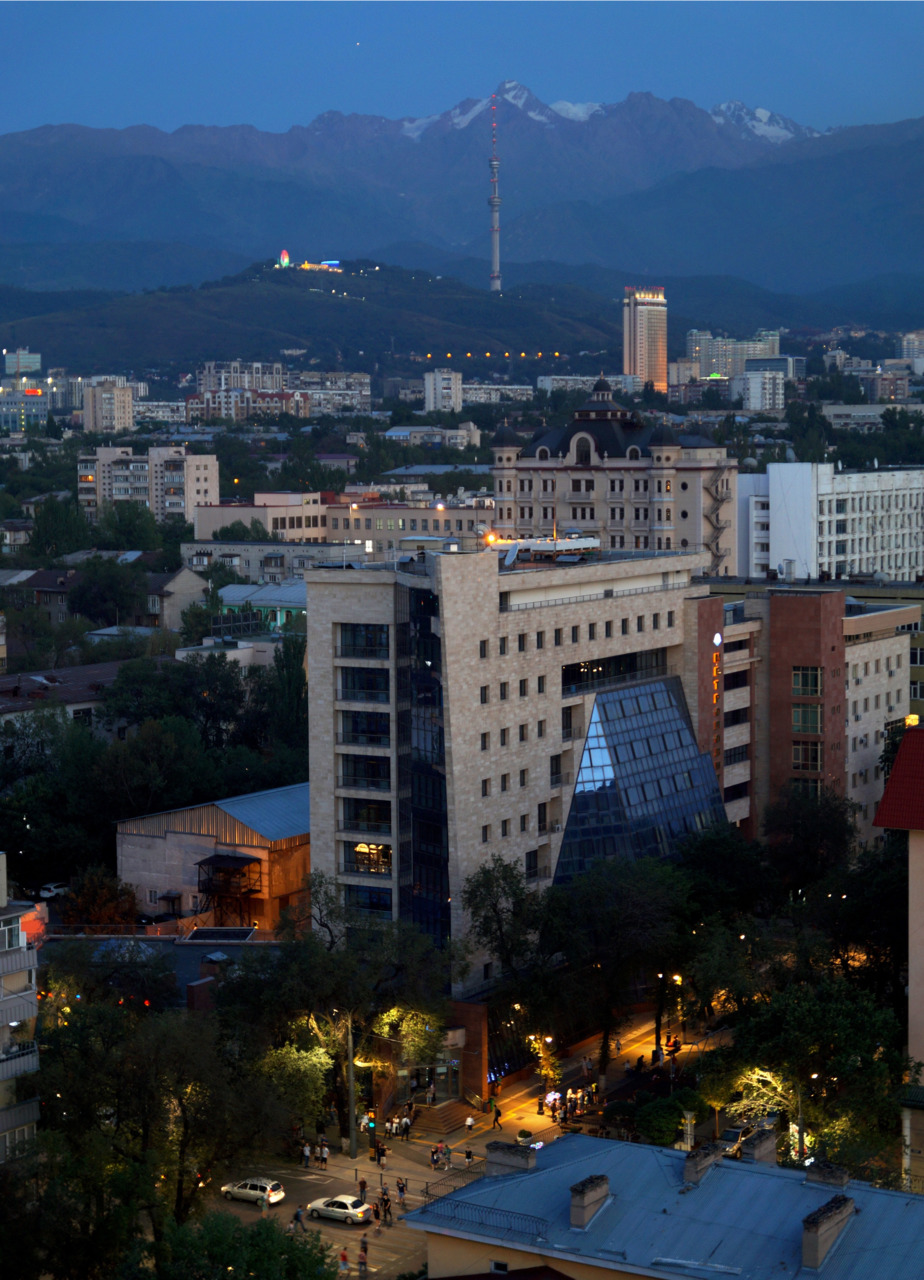
Part the first: City and mountains
Taiga, Arctic, and apple orchards in one window
Southern lands of Kazakhstan are a unique geographic margin, a distinct border, separating two orthographic extremes. To the north of the country, up to the very Arctic Ocean, there stretch the greatest plains and lowlands, and to the south, up to the Indian Ocean, there tower the highest mountains of the planet.
And this border is so obvious that in the clear day one can see from the mountains hundreds of kilometers of surrounding steppes and deserts, and from the hot plain one can view from the same distance the sparkle of glaciers at the mountain peaks. There are not so many places of this kind on Earth. Very few, to be exact. And to be entirely exact, there are no places like this at all! And the first among equals is Alma-Ata, snuggling up at the foothills of Zailiiskiy Alatau. Many of its residents see glaciers and deserts from the windows of their apartments.
…Mountains aggrandize a human. The higher climbers ge up t, the proud they become. The one who climbed up the stairs in Medeo looks scornfully at those who are just at their start. Mushroom hunters crawling among the fir trees feel sorry for eaters, who are thronging near shashlyk grills down by the riversides. And from above, from ice-covered peaks, arrogant mountain-climbers observe all of them with a smile. (Imagine, if only mountain goats possessed human traits and thought like we do, they would just burst up with hoity-toity!)
But mountains are interesting not only because of their ability to boost someone’s pride. They are a unique manual for studying the nature, too. All those who learnt geography some time ago (and this science, the most people’s one of all sciences, all of us did learn) certainly remember about the altitudinal zones of mountains, which vertically repeat Earth’s natural zones, encircling our planets along its latitudes.
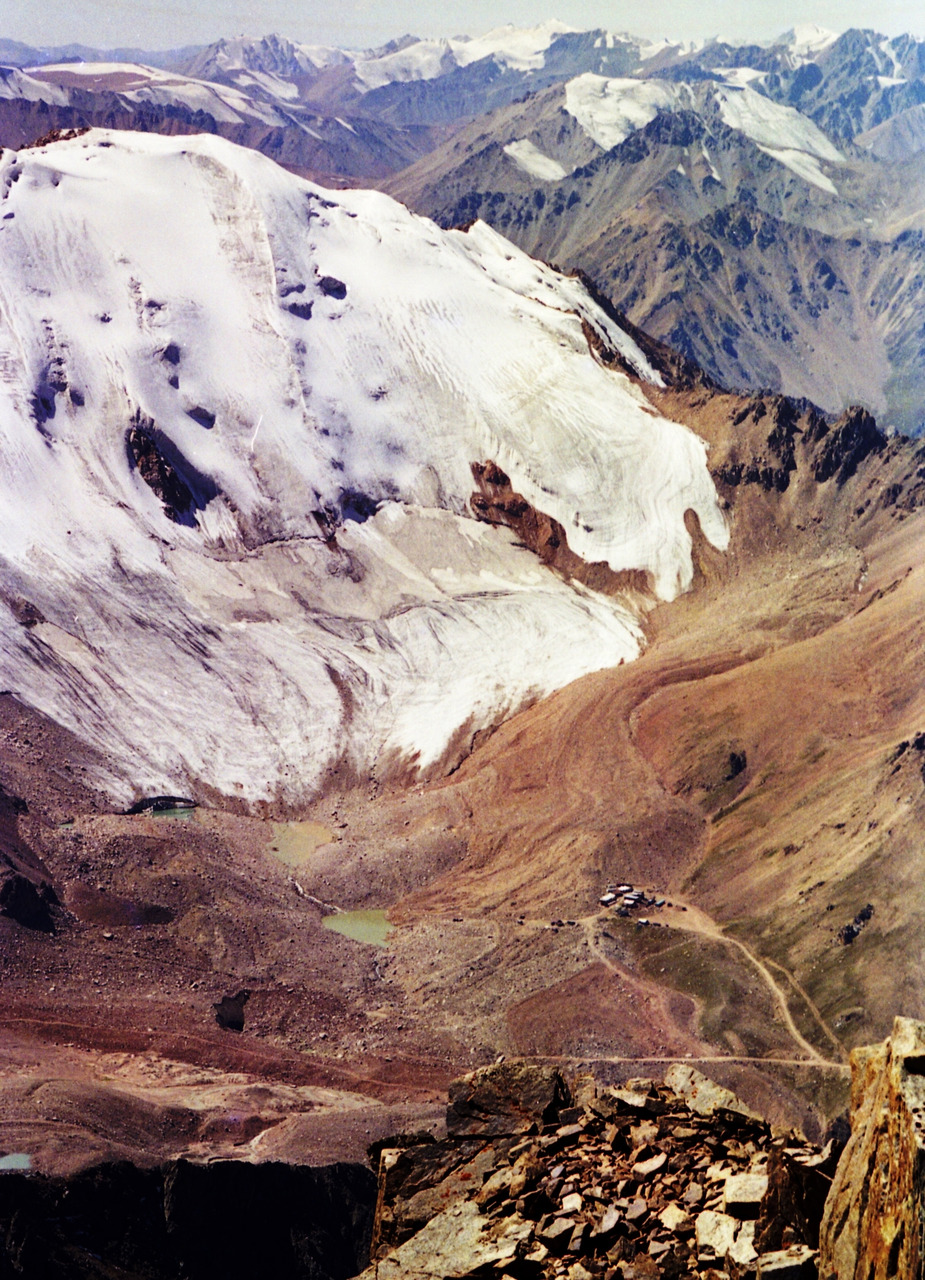
So, to reach the arctic ice, we, Almaty residents, do not need to go thousands kilometers up to the coast of the Arctic Ocean. We only need to take a cable car at our Medeo, and, provided we have enough money, within two hours we’ll wander about the real eternal ice of the glacier Bogdanovich, which differs little from those of Greenland or Spitsbergen.
But mountains are the Earth shrunk not only in space, but also compressed within time. The thing is that mountain slopes environments do not just repeat climate zones, moreover, they maintain conditions for the existence of relic plants and animals, which once swarmed these places. And thus, they are a unique shelter for many natural kings of the past and the source of species diversity for us. Examples are not far to seek: woods of wild apricot trees and famous apple thickets that gave our Apple city its name are relics of the past epochs as well. Just like alpine spruce forests.
For the convenience of outdoorsmen the nature thoughtfully cut mountain ranges with deep gorges. Each of our gorges is peculiar, each keeps its own zest down in its depths, and each possesses its own beauties and tourist attractions.
Thus, in Aksayskoye gorge, at the spot where two monks were shot by Bolsheviks, an Orthodox chapel was built, a popular place of pilgrimage today.
Bolshaya Almatinka gorge is noted by its alpine lake and a series of unique scientific institutions. Among them there is a sun observatory with its Carl Zeiss telescopes, which fell to the Soviet Union’s lot as a war booty after the World War II.

At the banks of Malaya Almatinka River there are famous sports bases of Kazakhstan: the alpine ice-skating stadium Medeo and Chimbulak ski centre with its piste of international class, going down 3,200 meters long.
The Talgar gorge leads to nature reserve of Alma-Ata, the oldest one in Kazakhstan, where under the protection of humans (from humans) a lot of unique species of mountain fauna live. And among them there is the animal that is the symbol of Kazakhstan, but not everyone can run into it. It is a snow leopard.
The Issyk gorge is known for its tragic event in 1963, when the severe mud flow devastated the alpine lake that was there, a popular place of public out-of-door recreation. Today this lake is being reconstructed and Issyk is returning to life again.
But in recent years the most popular place for tourists is the nearby g Turgen gorge with its beautiful waterfalls, forests full of mushrooms, lakes, alpine meadows, and the trout farm, where everyone at his/her pleasure can pay for the bite beforehand, cast the fishing rod to water and take out a strong wriggling fish.
Eternal glaciers within the precincts of Almaty city
Residents of the south capital of Kazakhstan Almaty, who wish to visit eternal ice, have two alternative ways. Either to go as far as a few thousand kilometers to Novaya Zemlya in the Arctic Zone (its glaciers are the closest), or to climb a few kilometers up to the mountains of Zailiyskyi Alatau, to the glaciers at the upper reaches of Malaya Almatinka river.

We know that the first European explorers of Tian Shan in the middle of the 19th century expected to find there a lot of volcanoes, but it was a great surprise for them to find glaciers. Such confusion was the result of theories of the great Germans, Humboldt and Ritter, who in their turn relied on half-magic Chinese sources. Somehow or other, the famous Semyonov-Tien-Shanskiy in his travels initially refused pointblank to see local mountain glaciers and took the eternal ice for “snow clusters”.
But now we know that all more or less great rivers of Semirech’ye are thoroughly replenished from the melting mountain ice. As a rule, glaciers get their names from a peak which slopes they slide down. Thus, among Malaya Almatinka glaciers that can be seen from streets of Almaty there are glaciers of Ordzhonikidze, Tuyuksu, Pogrebetskiy, Molodezhnyi, etc.
One of the Zailiyskyi Alatau glaciers has the name of the specialist in local history Dmitriyev. It was he who first explored glaciers of Zailiyskyi Alatau. In the “Proceedings of the Emperor’s Russian Geographical Society’ as of 1907, the specialist in local history S.E. Dmitriev described the experience he had had during his expedition to Malaya Almatinka glaciers in the late summer of 1902.
At that, no one had ever provided Dmitriyev with any “grants” for his research, and no one even had asked him to do it. All his explorations are just his personal initiative for the study of the surrounding world. The following facts expressively speak about many unknown and unexplored things of those years. Glaciers that were described by the amateur glaciologist hundred years ago were one and all untitled. They were not even registered on the three-verst scale army topographic map of that period.
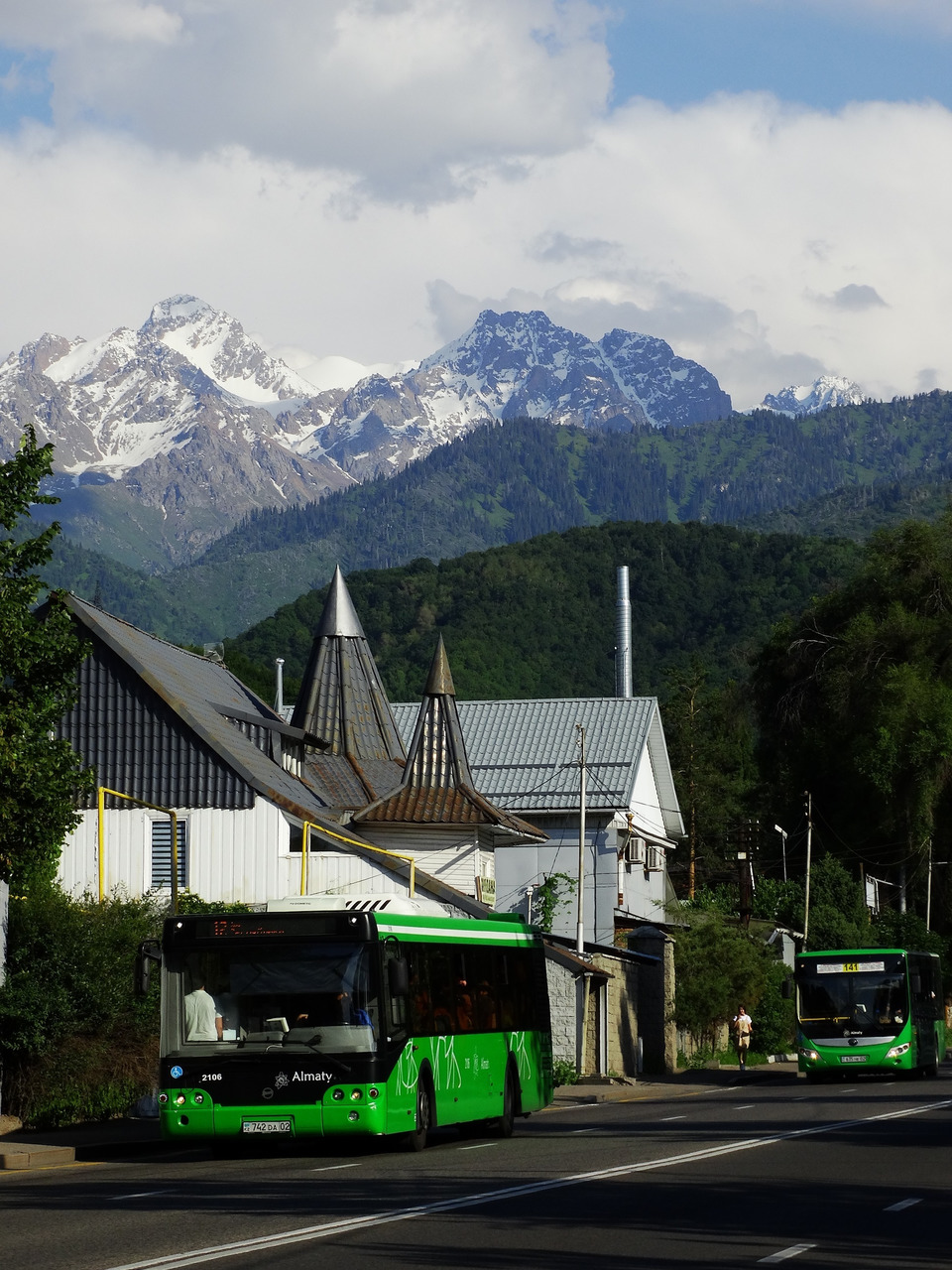
Dmitriyev’s studies continued for several years, being very occasional, though. He measured the glaciers by eye and by footsteps, and, what is more, he built the first weather shelter here and also tried to answer such questions as what was happening to glaciers. What speed they move at? Does the ice array decrease or increase? Those who are eager to know that can read this information in his works and reports.
Residents and visitors of Almaty may escape studying all the facts of the secret activity of glaciers. They have a unique opportunity of waking up in the morning in their warm cozy beds, climb up to the real ice tongue (arctic!), have a lunch out in the fresh frosty air, and come back home for dinner. Personally, most of all nearby glaciers, I like a walk towards Molodyozhnyi (“of youth’) glacier (somewhere around there stood Dmitriyev’s weather shelter). This glacier looks like a huge wall of ice that covers up half of the sky.
If you find yourselves here at the end of August you may see everything sparkle in thousands of streamlets in the last summer sun, sing in dozens of clear voices, savoury crisp in azure granular snow, or firn, under your feet, and excites with its unmatched cool fragrance. And in case you reject any transport and come here by foot, you will add to all this the feeling of self-esteem, which will grow right before your eyes!
Alpine crown of Alma-Ata
The route to many alpine peaks, crowning the Alma-Ata scenery, goes through the “Small Almaty” gorge, nearest to the city, known far beyond the borders of Kazakhstan for its high-altitude skating rink “Medeo”.
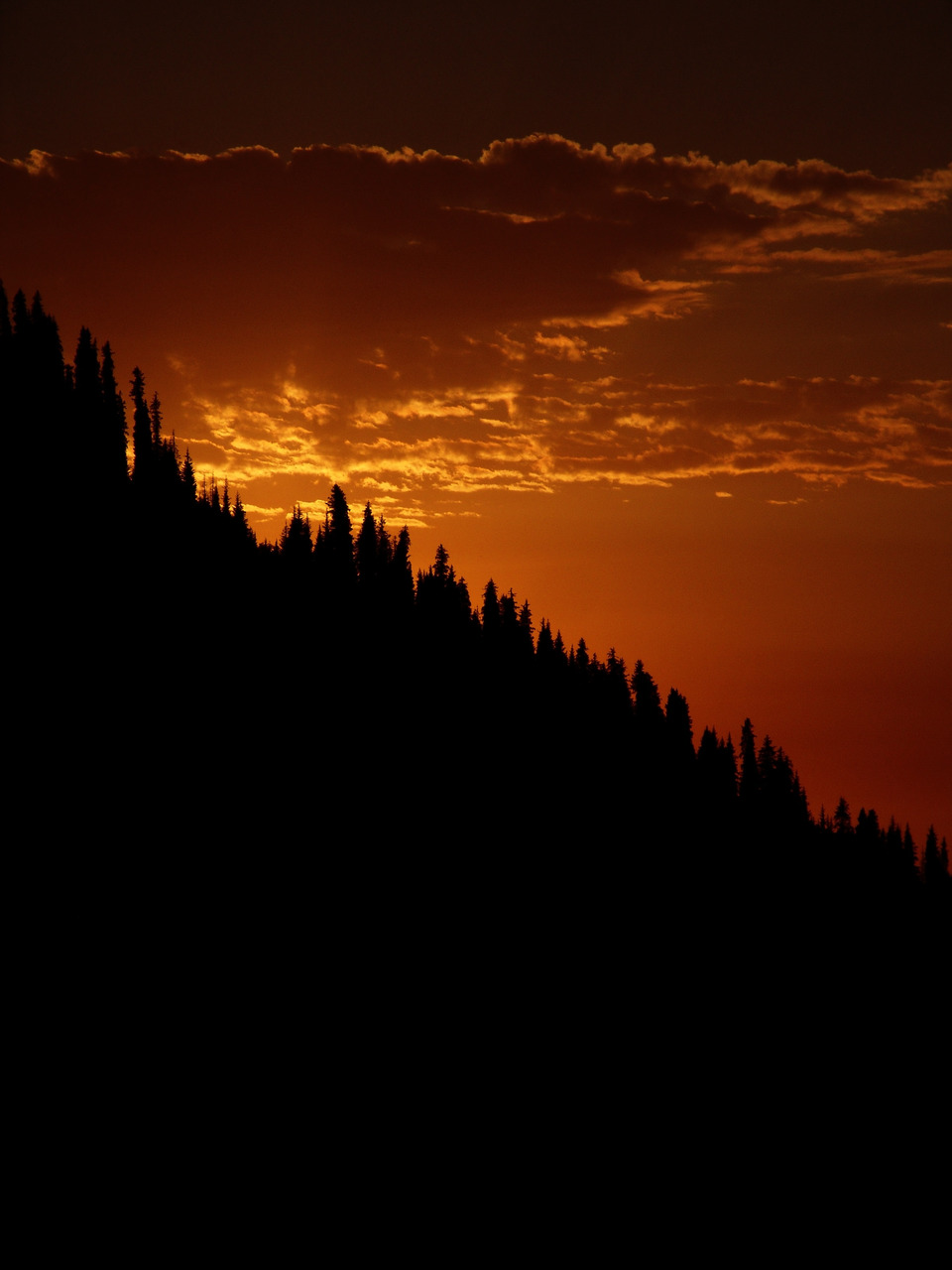
To start ascent you need to wake up early in the morning, take the regular bus from the hotel “Kazakhstan” to “Medeo”; from the skating rink you can use the cable way to get not only to ski resort “Shymbulak”, but also to Talgar Pass (3200 meters).
Low peak “Shkolnik” is a “category” peak closest to the city; it towers just above the ski-run. It is the unchanging arena of dozens of mass mountaineering competitions since the 30s. And even today, the peak “Shkolnik” (schoolboy) is lives up to its name, and continues to be an initial step for many people who try their first steps in mountaineering.
The Bogdanovich glacier cirque lies right on the other side of Talgar pass with peaks: Komsomol (4376 m), Phiskulturnik (4068 m), Chkalov (3892 m), Karlytau (4100 m), Pioneer (4031 m), Teacher (4045 m) and others. Easy accesses to these peaks made them the most visited sites of “climbing weekend”.
In 1934, Bogdanovich glacier area has been developed before others in Zailiyskiy Alatau. Almaty climbers led by B. Lobanov summited peak Karlytau, a snow-white the year a round top with perfect clean lines. In 1937 A. Bekmetov’s group summited Peak Phiskulturnik (Athlete). Chkalov peak was conquered by S. Pasterevov, B. Pomeranzova and H. Rakhimov in 1936.
But if you do not climb the Talgar pass, but ascent from Shymbulak along a Small Almaty gorge, you will get to other placer of even more interesting peaks at the riverhead. When you get to the upper border of the spruce forest (it runs in Ile Alatau on altitude 2,500 — 2,800 meters), you will see gloomy, bleak cliffs of another popular peak for ascents — peak Abai. It was summited by local climbers led by G. Beloglazov in 1933.
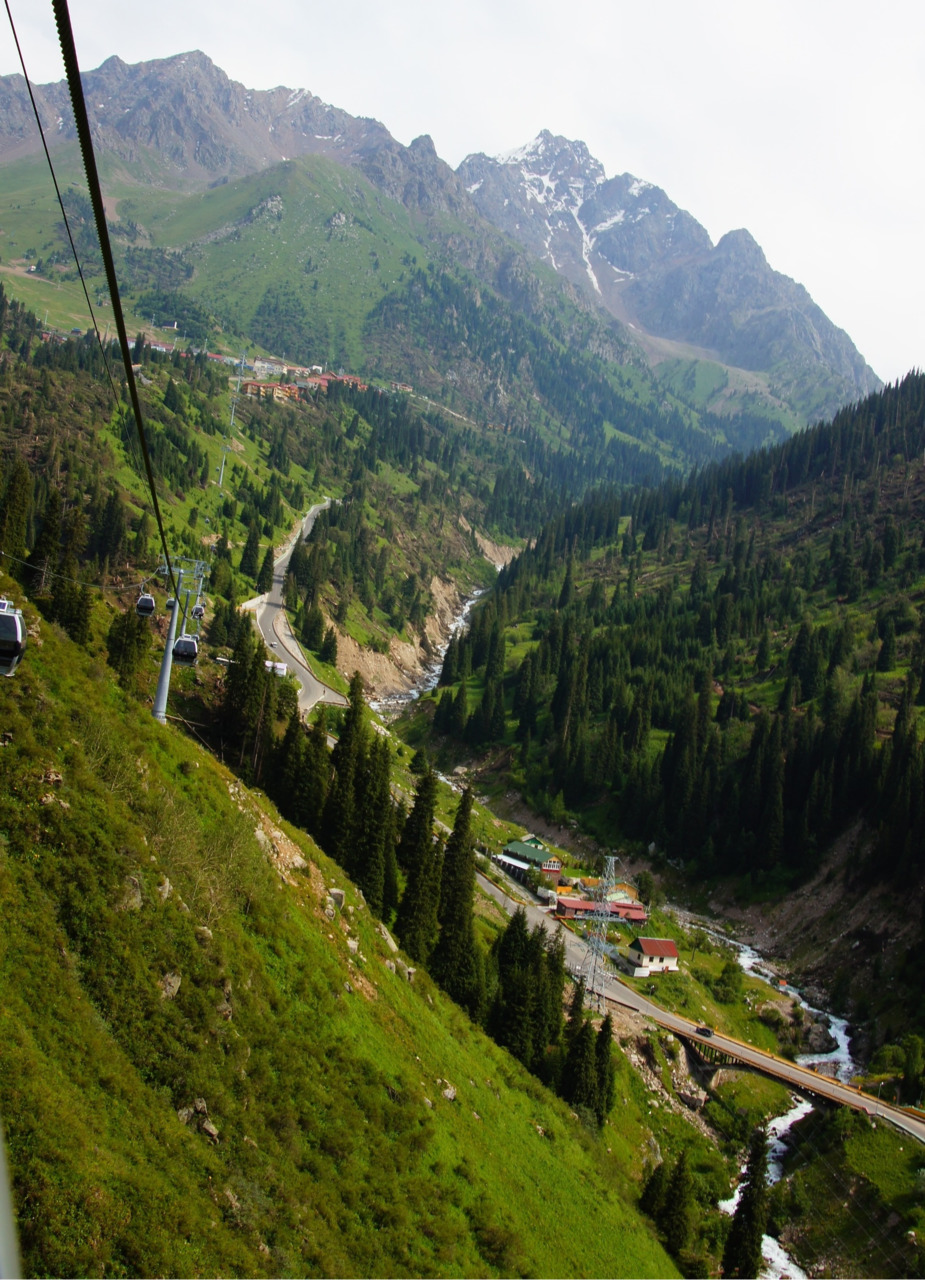
After Mynzhilki — a small alpine decline,, the road begins to rise onto the chaotic pile of stones of the huge moraine Tuyuksu. And from there, you can see a beautiful alpine panorama that worth looking at. This is the peak of Great Patriotic War (4050 m), Antikainen (4000 m), Panfilov Heroes (4120 m), Pioneer and Teacher (we have seen them from Bogdanovich glacier) and Amangeldy peak (3999 m).
As you learn the names of the peaks, you can clearly see the connection with the events of the Great Patriotic War. Indeed, the first ascents happened at beginning of the cruel 40’s, when Ile Alatau mountain were used for training instructors the for the Soviet Army. Names of peaks carry responses to the front-line events. The 28 Panfilov heroes performed their feat near the Moscow, and in that winter, group led by A. Maleinov, named one of the peaks in their honor. Other names of peaks appeared on the map later (1944): Manshuk Mametova, Great Patriotic War, Zoya Kosmodemyanskaya (in the area of Tuyuksu glacier).
Ascent to the moraine ends, and we can see even more spectacular and majestic landscape that attracts with its beauty and purity. The peak Youth (4147 m) stands right in front of us, entirely covered in ice shell wall. Peaks Zoya Kosmodemyanskaya (4108m), Lokomotiv (4182 m), Pogrebetsky (4231 m) and Tuyksu (4218 m) are located further along the ridge; there you can also find seven small sharp peaks — Tuyuksu Needles (4213 m).
A traverse (route over all the peaks) lies under the Needles; it has the fourth category of difficulty, for the first time, climbers passed it in 1940. Another popular traverse terminates here; it calls Horseshoe Tuyuksu, for the first time, G. Kolenov and B. Nearonskiy conquered it in 1945. This route also includes peaks Partizan (4390 m), Ordzhonikidze (4410 m) and Mayakovskiy (4208 m).
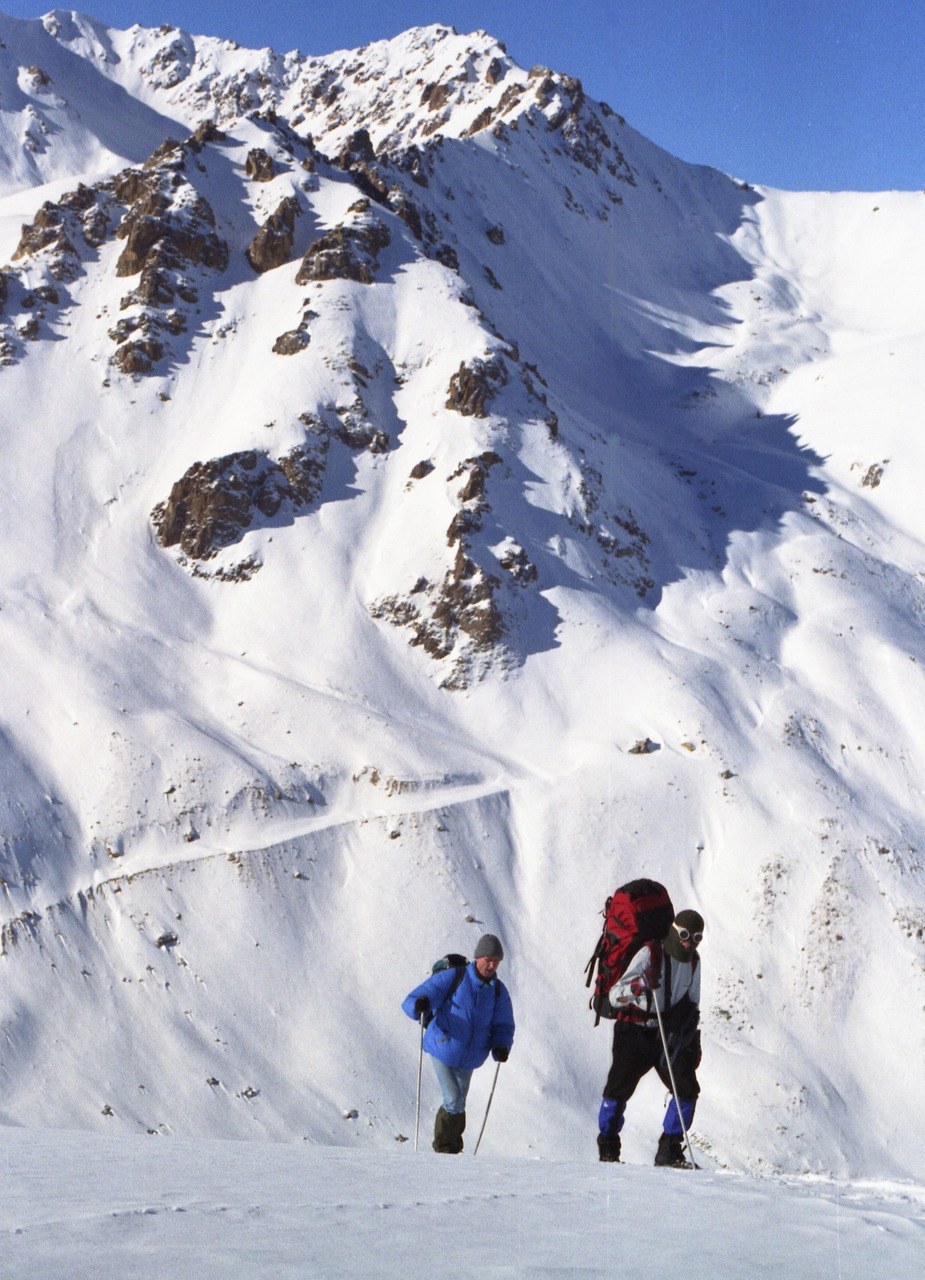
Peak Mayakovskiy well known for its north-western side, here one of the most difficult climbing route in the area lies there; authors of this route are G. Petrashko, V. Savinykh, B. Shklyar and B. Reznik (Spring 1962).
Now, the reader knows that Ile Alatau is a unique training complex for climbers. According to its geographical position, this ridge is one of the most northern highlands on the planet. So peak Talgar (4975m), for example, is not inferior in climatic conditions to the southern mountains over 7000m high. If we take into consideration the fact that the ascents take place in Ile Alatau almost the whole year round (except for short breaks because of avalanche danger), then it becomes clear that Kazakhstan sportsmen and mountains lovers have unlimited possibilities. Indeed, they have a wonderful alpine stadium.
Alpiniads in Zailiskiy Alatau
At the dawn of its development the Soviet mountaineering was not only a sport, but also a peculiar activity, an area of energy use for young builders of communism. Such unlike spheres as the pastime, study of Motherland, the Red Army tough soldiers training, and the collective labour were interwoven within it.
Per se the whole sport in 1930s was a mass sportive event, and “we” was a favourite pronoun of the first soviet hikers. That is why, not accidentally in that period there emerged such a type of climbing when a peak was being conquered by a few hundred people at the same time. By analogy with Olympiads they were called “Alpiniads”.
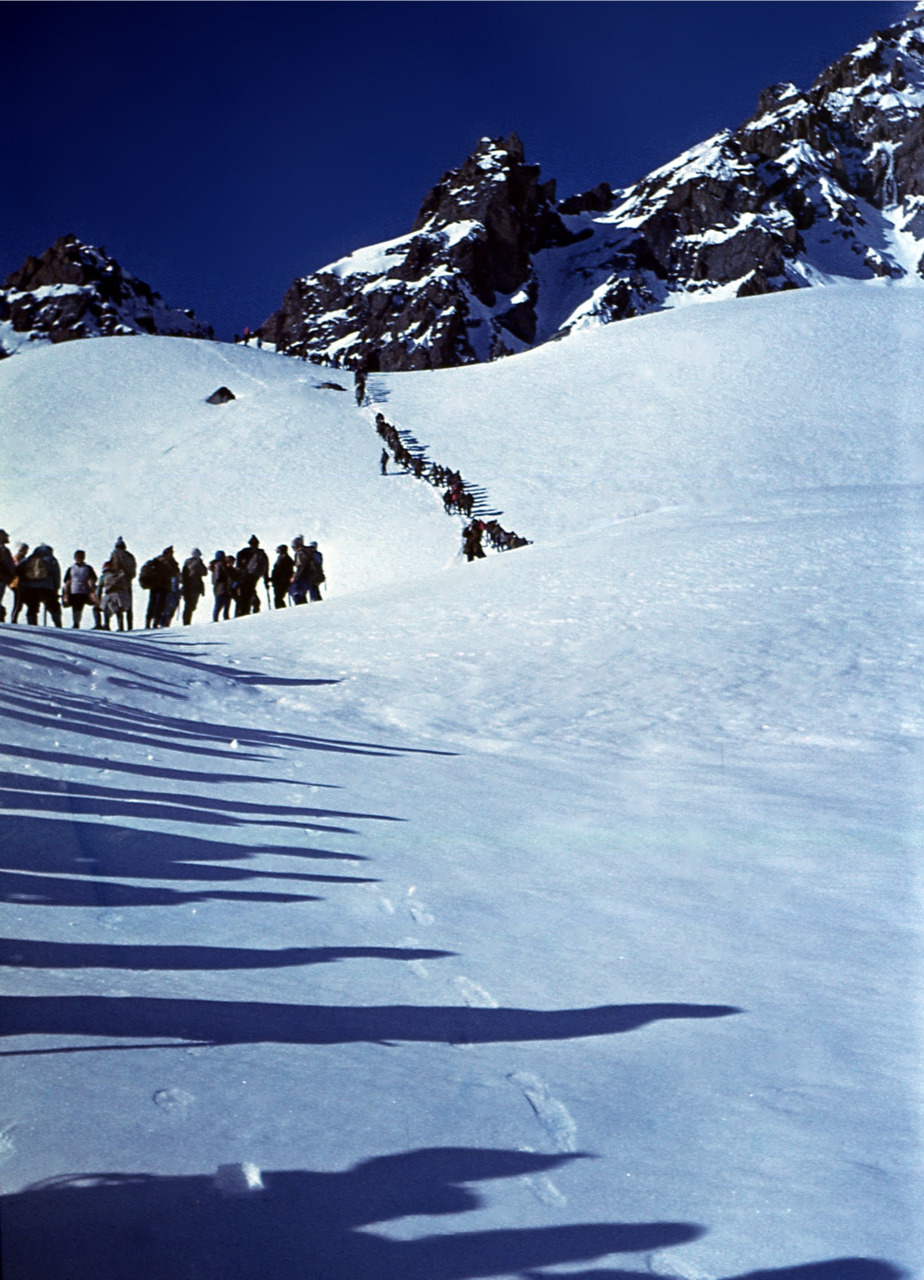
…The register of Kazakhstani mountaineering is usually done from 1930, when G. Beloglazov, V. Gorbunov, and I. Myssovsky conquered Maloalmatinsky peak and planted a red banner on its summit. And the beginning of the especially fast development of this sport in Kazakhstan was marked by the first mass mount of seventeen people headed by Victor Zimin to the same peak in 1934.
This success lent them wings, and next year they decided to accomplish the Mass Komsomol Alpiniad to Maloalmatinsky peak on the model of Caucasian hikers. Why are the first mounts in Zailiskiy Alatau related just to this peak? The reason of it is its closeness to Alma-Ata and the relative availability of approach. Surrounded by many alpine peaks, this one attracts imagination to itself solely by its sight and calls to test men’s valor. At that period the idea of the mass climbing seemed rather audacious though. But how all this was in tune with the character of the epoch!
…So, the long-awaited July of 1935 rolled around. Komsomol members decided to dedicate their Alpiniad to the 15th anniversary of Kazakhstan. Despite the hard times, common boys and girls of the Soviet Union were all enthusiastic in those years. Therefore many things may seem strange to their today’s equals in age.
For instance, following the spirit of those times, throughout the whole route, right along the path, young climbers were to issue wall newspapers under such titles as “We shall reach it!” “We shall win!”, and others. The last issue was made at the very summit under the title “We win!”.
Those years any event, if only it was possible to use aviation, could not do away without airplanes. The alpiniad members were ecstatic when an airplane suddenly appeared above their heads and dropped a pile of leaflet.
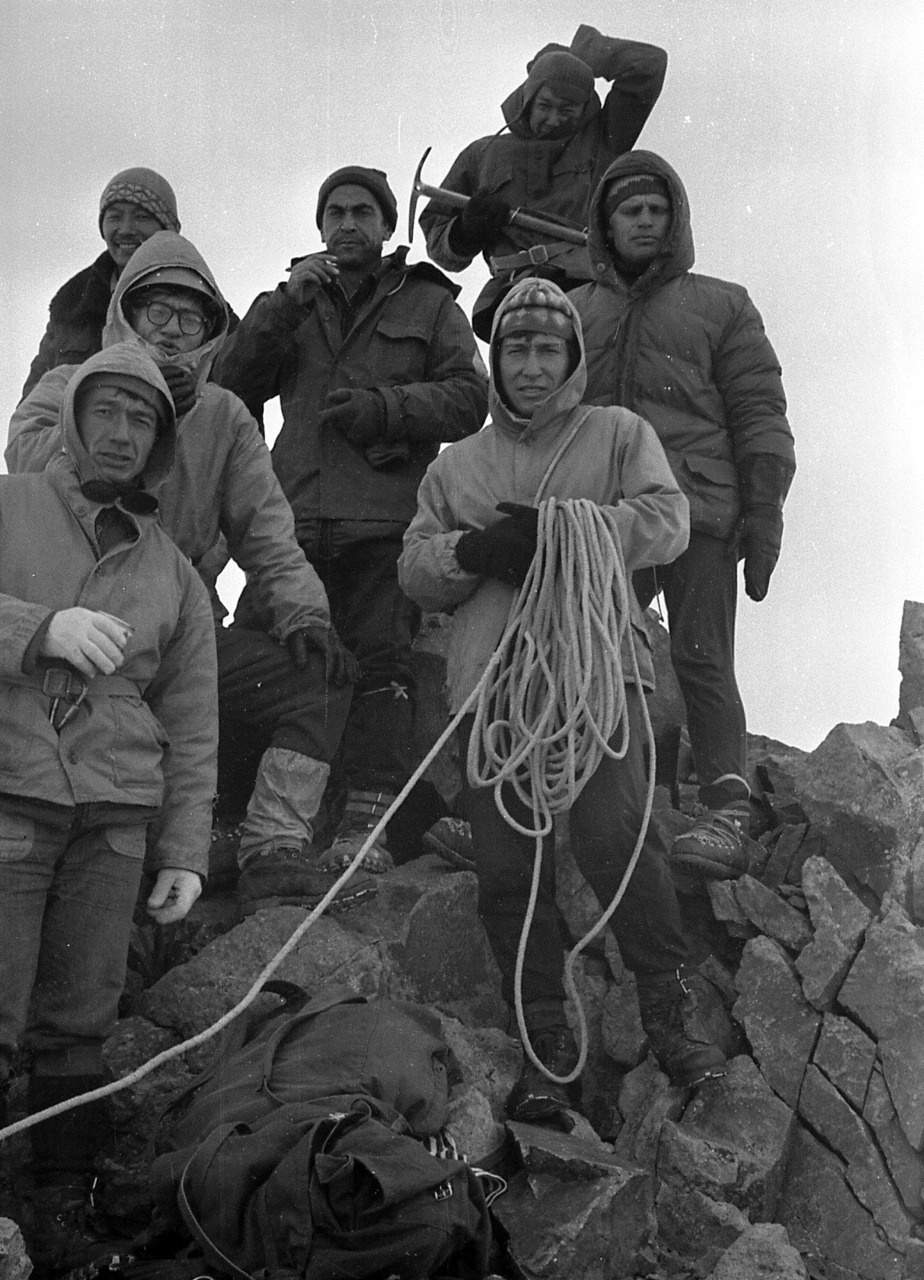
The Mass Komsomol Alpiniad was considered significant not only as a sporting event. Not without reason organizers and participants of this mount became K. Komarov, the secretary of the city Komsomol Committee and K. Tashtitov, the secretary of the Central Committee of Leninist Young Communist League of Kazakhstan.
Out of 267 participants 250 people climbed the summit. It was a victory! A bit later, in memory of this Alpiniad, Maloalmatinsky peak was renamed Komsomol peak.
And below, downtown, in the Federation park the hikers were awaited by the most sincere and solemn receipt: with flowers, orchestra, speeches and placards, in the manner all winners were honoured at that time. The head of these first mass mounts was Victor Zimin, a participant of the civil war, “a 25-thousand worker”, who had come to Kazakhstan to develop the mass physical training movement.
But this mass record was soon beaten. Within a month Komsomol peak was conquered by 365 (!) people: NKVD soldiers and commanding officers under the guidance of the last alpiniad participant I. E. Glatolenkov. Among the conquerors there were six women, commanders’ wives. Atop, following the rules, mountaineers set up a small bust of F. E. Dzerzhinsky, the patron of the All-Russian Extraordinary Commission NKVD.
The year of 1935 survived in everyone’s memory due to other reasons, too. In Alma-Ata for the first time in the country there was founded a new public organization, the Hikers’ Club. It was a methodological (and political!) center, an assembly place, an organizer of mass mounts and difficult expeditions, and it played the important role in mountain and sports development in the republic. It is majorly thanks to this club’s activity Zailiskiy Alatau very quickly became the second after Caucasus region in the country for the mass mountain climbing.
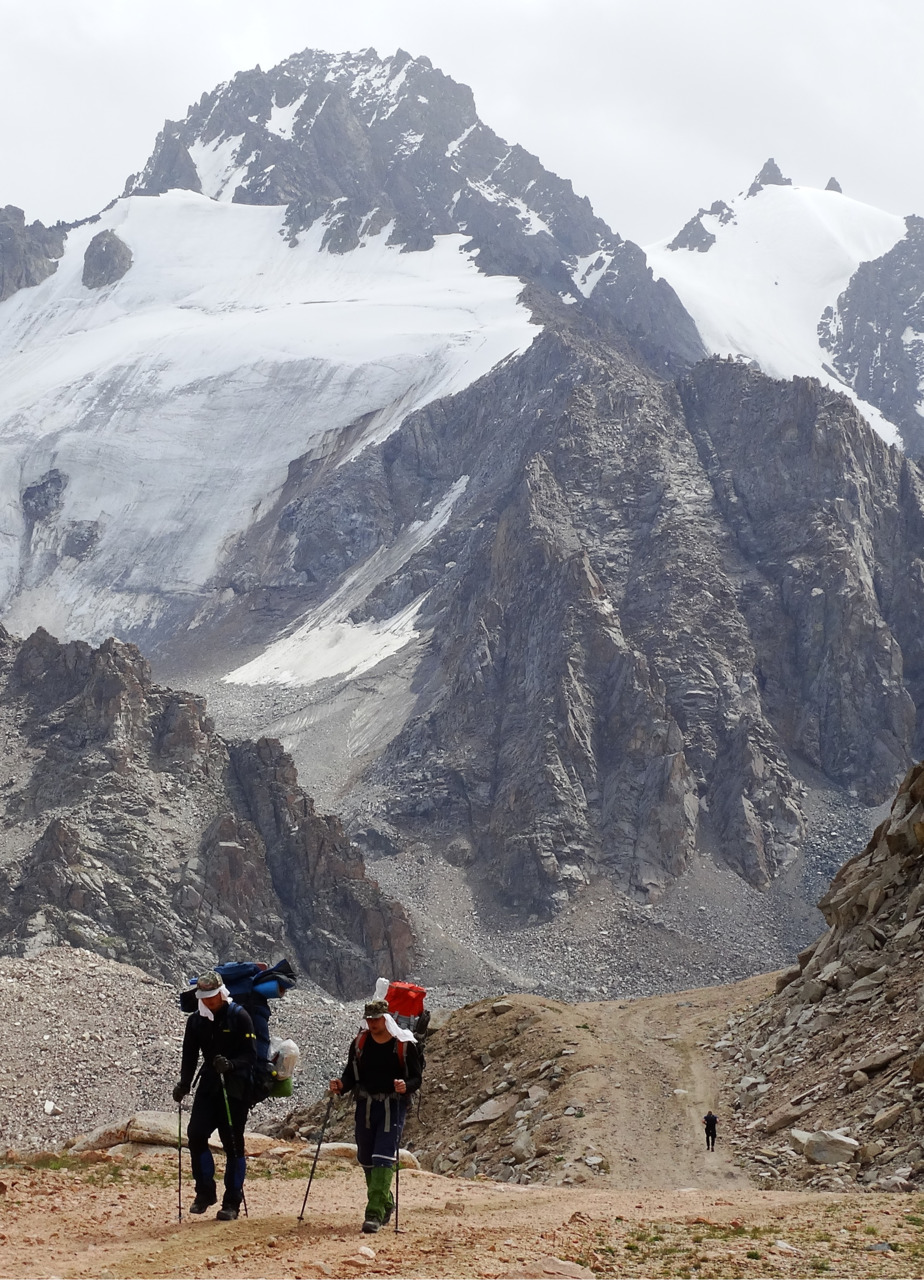
…Interesting that the tradition of mass climbs survived up to nowadays. And the author of these lines happened to be the participant of them in his hiker’s youth in 1970s. And it stuck to my memory. As a matter of fact, such mass mounts when a few hundred people all in one walk to the summit is an unforgettable spectacle.
The first sunbeam that has slipped from behind the nearest mountain catches the alpiniad’s participants already on the move. The chain of people stretches for many hundreds of meters; they busily crisp with their heavy boots against the frozen snow, hammer stones with ice axes, intently breathe in the frosty air and together feel sorry, silently and out loud, for those who stayed below, downtown. And although not everyone who walks in this column for the first time will get to Himalayas, or become hikers, even if they never make the mount again, this proud acute feeling of the conquered peak will stay within them forever.
…This tradition keeps on living in the new Kazakhstan, too. The regular climbs to the legendary Komsomol peak (hastily renamed by the sportive org-men the more accustomed to the today’s ear Nursultan) attract in the same way both veteran hikers and newcomers
Medeo skating rink that we’ll love forever!
The alpine skating rink Medeo is more than the sports venue. We may surely say that there’s no other such a popular Olympic brand in Kazakhstan.
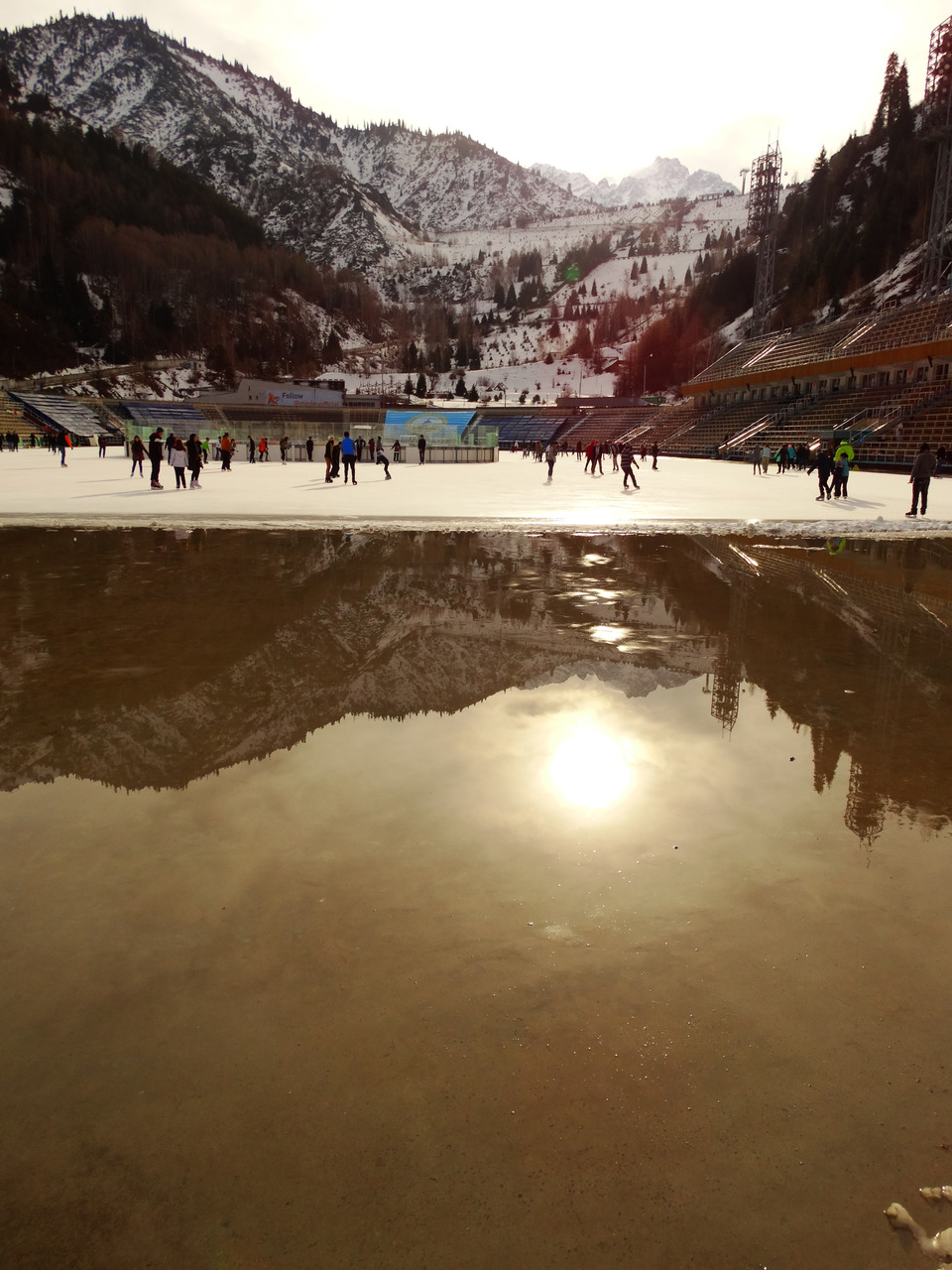
And though much time passed since that period when this alpine skating rink was rightly called “the factory of records” — memory remains. And not only with the chroniclers registering the world sports achievements, but also with all those who skated, skate and will skate on Medeo’s speedy ice.
Right after its opening Medeo became people’s favourite place for spending their time off. In those years when the chilling equipment of the rink functioned properly, it was open from September till April. Although for all comers it was open only at weekends, the annual attendance figure reached 150 thousand people!
To visit Medeo with friends, “to go skating” was a usual and common thing for us, young Alma-Ata residents of that time. (Despite the fact that it was never easy to get there by bus.) Sometimes in warm days of autumn the skating rink was fully crammed with skating people. But — so many loving hearts found each other in these crowds! So many sudden collisions led to long-lasting relationships!
As for these photos, they were taken recently. Today the second and the third generations of Medeo fans skate on its ice.
Winter in Zailiyskyi Alatau
In mountains winter reigns longer than it does at their foot. And at the highest peaks, where bare rocks argue with eternal ice, its vacation is shorter than that of any civil servant in Nursultan. The sun will just warm up the tops and melt all the winter snow, but here we go again — black clouds are coming from behind the ridge, and icy rain begins to powder the slopes with the snow grains.
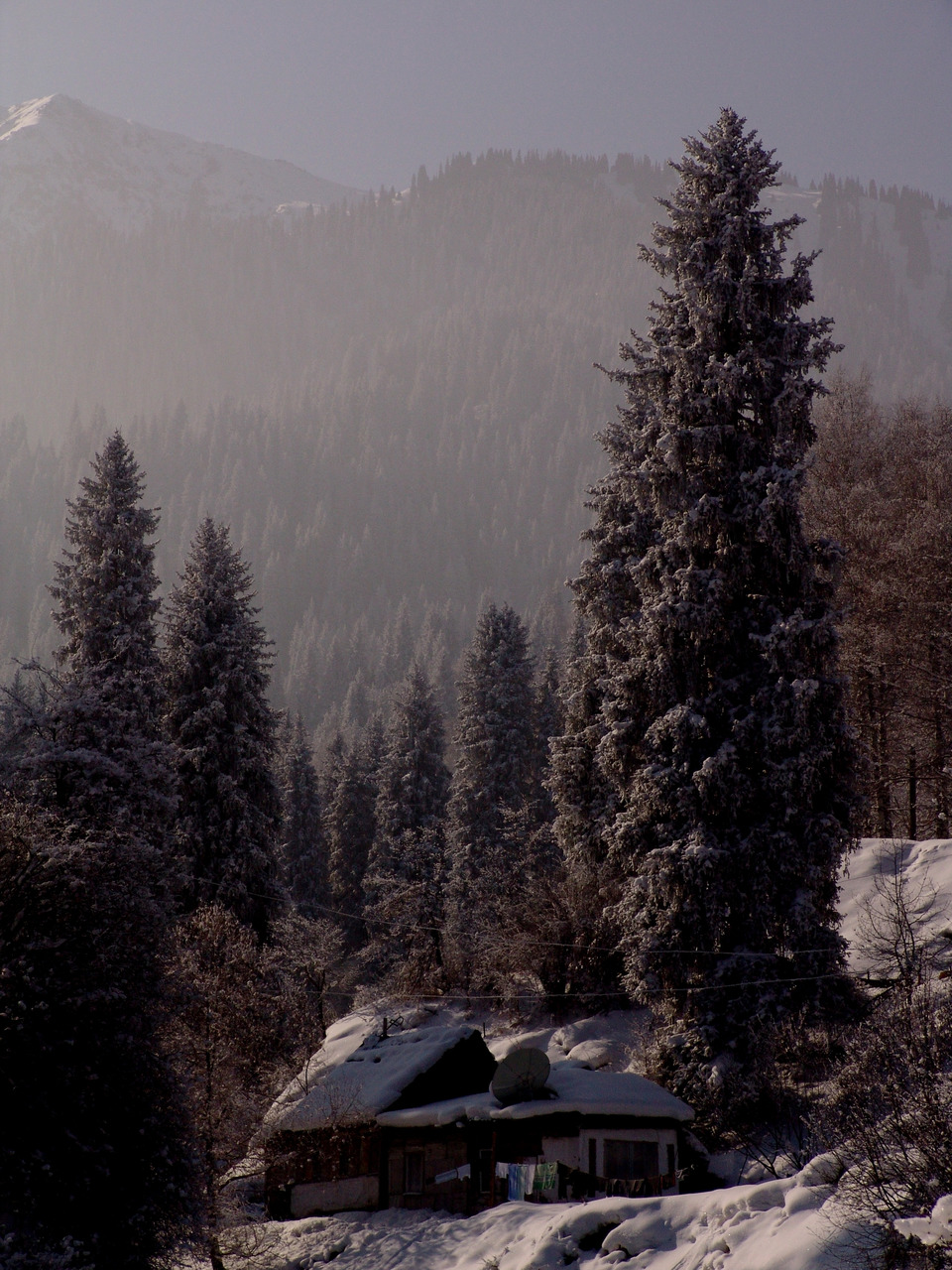
Middle altitude mountains with their lush forests and fir woods are another matter. We have the full-scale summer here. With hovering butterflies, fragrant raspberries and warm sun showers. Both spring and autumn are never reminiscent of bustling and hustling holidays here. That is why winter, as if understanding its soonest resignation, tries to do its best to show off. So, it presses fur boughs with piles of snow nearly down to earth, transforms rapid mountain streams into sparkling crystal, and buries strewn sharp boulders under layers of snow 1 m thick.
Our mountains are calm and quiet in winter. If you skirt few mountain cabins, shashlyk-smelling Medeo and arrogant Chimbulak, you can go deep into such forest serenity and such benchmark primevalness, which is haunted by amateurs from distant places, covering thousands kilometers, crossing many borders, and spending lots of money. Any Almaty citizen is a man of destiny in this regard. To see and feel all this bliss he just has to take a 30-minutes ride by bus and to pay 80 tenge only.
Alma-Ata: the winter tale
I can say nothing about the today’s capital of Kazakhstan, but the former one — Alma-Ata — is lovely at any time of the year. Including winter. Despite the languishing epithet “south”, given to the city, and that it is situated in the same latitude with Istanbul, Rome, Barcelona, and New-York, stems of thermometers once fell here below 38°С. As for the snow, there is so plenty of it here, that Winter Asian Games were already held in the city, and it claims to have Winter Olympic Games with all good reason!
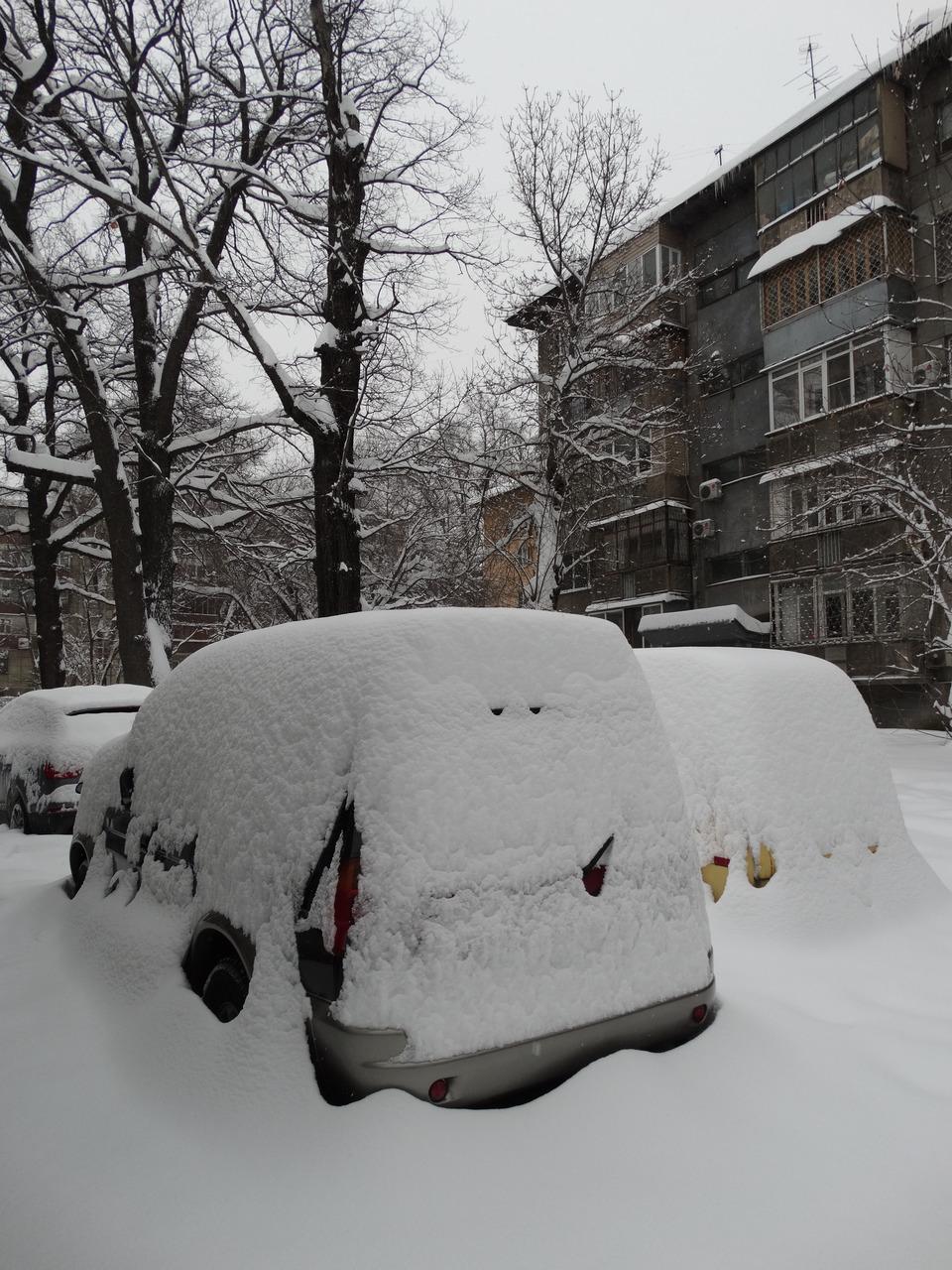
As for the citizens, I won’t palter with truth: our attitude towards winters can’t be called lock, stock, and barrel positive. Predatory bills for heating from utility providers alone can easily envenom anybody’s life. But the pleasure felt by south people in winter, who have been well-warmed and tired during the summer heat, cannot be compared to feelings of inhabitants in those cities where they manage neither to warm up nor get tired during summer.
There is one thing I can declare unequivocally — our city looks so solemn, fabulous and full of light only in the morning after a snowfall, and no other moments. When the sun that has risen from behind the mountain tops in a flash of a second will decorate snow piles and snowy trees with millions of sparkles, flutter with celestial shadows under heavy branches, and shine on rosy cheeks of student girls, hastily going to their lessons. This is an incredible state of mind and soul!
Our Cathedral!
This elegant building in the center of the old park is one of the main decorations of the city for more than 100 years. (Name of city was changed three times: Vernyj — Alma-Ata — Almaty during this time).
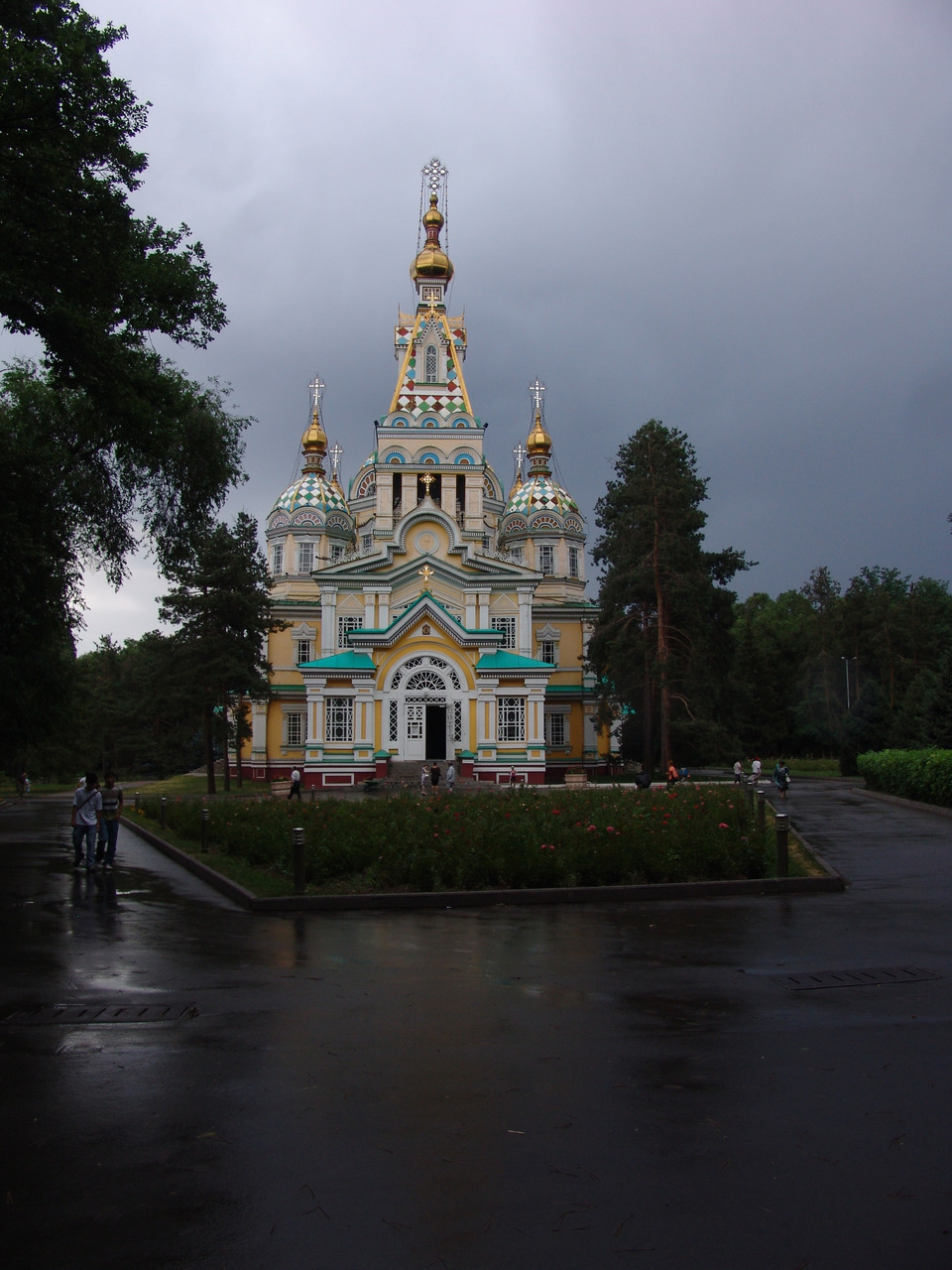
Orthodox Saint-Ascension Cathedral was built by the most recognizable Vernyj architect and town planner Andrei Zenkovin 1906; and it immediately became one of the attractions of Semirechye region and pride subject of parishioners and townspeople. Pride hesitet during the severe earthquake in 1911when a lot of buildings were destroyed, but a 44-meter Cathedral withstood (its predecessor, by the way, was destroyed by the disaster in 1897). Let me remind you that it was not some indistinct shocks that townspeople got used to, but the earthquake measuring 8—10 on the Richter scale!
Stability of the Cathedral has proved Zenkov’s anti-seismic construction approach. Wooden frame made from strong Tien Shan firs, fastened together with iron pins in a flexible structure was put on the monolith of reinforced concrete. Many high-rise buildings are being built according to this principle in the southern capital.
Cathedral resisted the next disaster as well; this time it was social disaster, when militant atheists unleashed their anger on everything that reminded of God. The Church, however, was kicked out of the temple; the building was a museum during the Soviet times, well known to everyone who read the novel “Keeper of Antiquities” by Dombrowski. The bells were dropped, but crosses stayed.
Later Cathedral became concert-exhibition hall. And then it was returned to the parishioners again. But regardless of all of this, the true citizens of all political preferences, religions and nationalities continue to love and be proud of this wonderful building in the old park. And our love does not age! I know myself that it is impossible to pass by, even if in a hurry. You will turn from your way just to admire this majestic heritage of the city once again!
Love and dove
In the very heart of Almaty, in an old park, nearby the magnificent Voznessenskiy cathedral, pigeons have reigned for more than one century.

Here, to one and the same permanent cooing and flickering wings flapping, time goes in different manner than at any other place. Time goes slowly here. And if there is some peculiar Almatynian rite of passage, connecting such different peoples and such unlike generations that inhabited and are inhabiting our city, then it performs right here, in the shadows of the temple.
Every one of us visited this place in his childhood, with his parents, absorbedly fed and enthusiastically chased these agitated birds, and then brought along his own children to this place for them to do the same thing, later his grandchildren, and — he who was lucky — his great grandchildren. Thus, pigeons of the Voznessenskiy cathedral (how many generations of them there were, no one knows exactly) are this very alive link that connects Almaty citizens with their past, future, and with one another. It equals local citizens with newcomers. And makes everyone love this glorious city.
The Recreation Park
This park is nearly of the same age with the city of Vernyi (now Almaty). Its fortress and settlement were founded in 1854, and the Public garden at its southern outskirts appeared in 1856. However, its primary mission — to be a transplant nursery and provide local farmers with young fruit plants — very soon (as soon as trees accrued) faded into insignificance. As for the leisure zone, it became more significant, and it was appreciated and loved by city people.
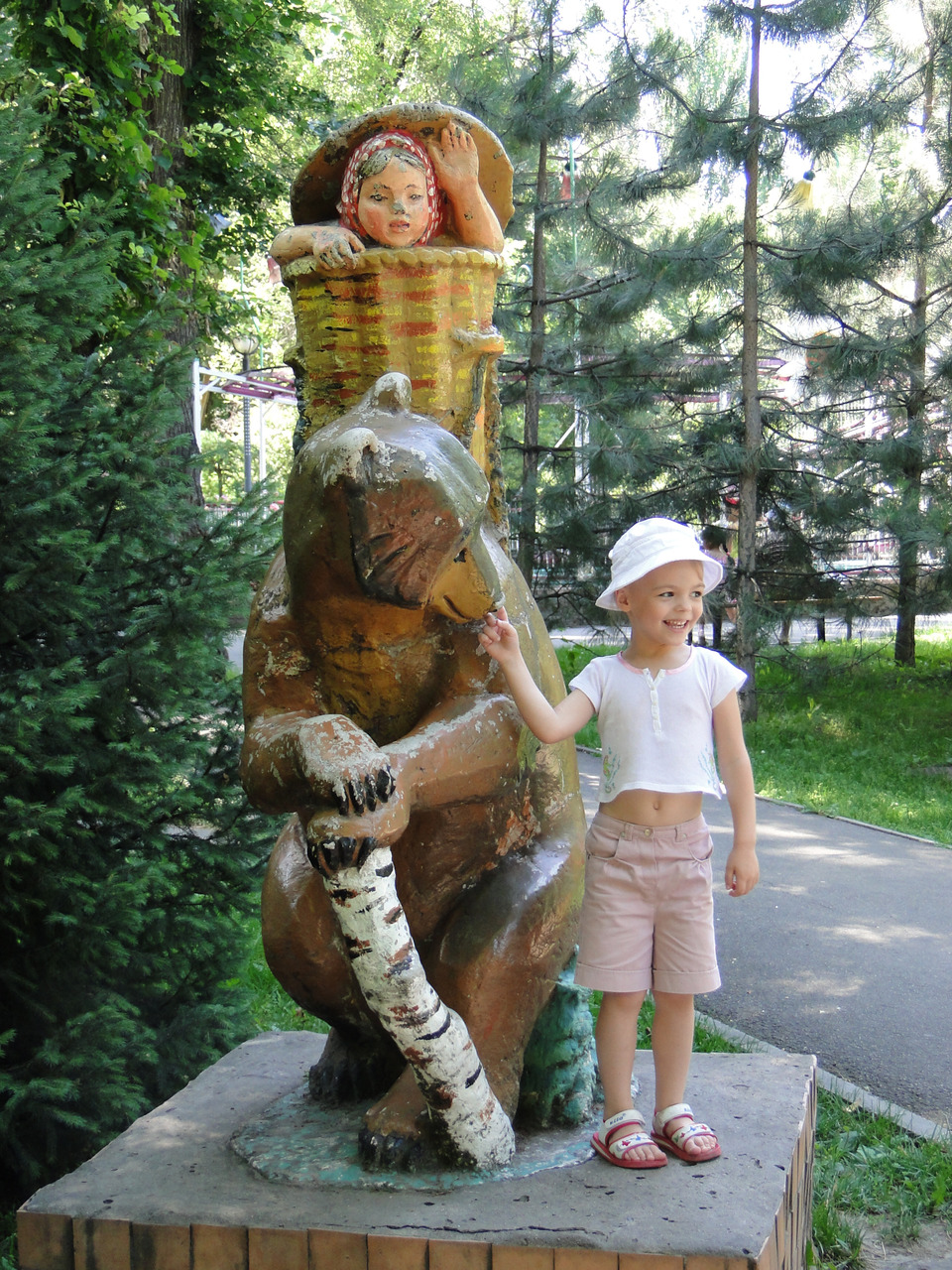
We have trees (through thick and thin) and alleys dating from that period: birch, oak, poplar, and pine ones — they were planted by students from the local gardening school 100 years ago. Plus the pond with an artificial small island that emerged here in 1870s. And — this strange attraction that city and suburban residents of all ages still feel towards this shady park.
In my childhood the Central Recreation Park named after Gorky (Gorky parks existed in Moscow and in cities all over Soviet Union) was always the place of festivity. Despite the simplicity of amusement rides and the explicit shabbiness of food courts, the reckless excitement from entertainments added to the enthusiasm of Soviet people did let us enjoy the real proper rest. Some amateur performance at the open-air stage, Ferris wheel, children’s railway, cotton candy for kids and incredible but delicious shashlik and beer for adults, the obligatory visit of the adjoining zoo — all this I still remember in minute details.
In fact, an unspoiled person doesn’t need to rush to Disneyland to get some good rest anyway. Even more so, nowadays the park is changing right before your eyes and becomes better and more cultured.
Alma-Ata Zoo
I remember it as much as I remember my own self. Because it is our good old tradition — to visit this zoo together with your child. Not only all native Almаatynians have gone through this tradition, but the majority of people inhabiting the whole republic, too.
It even seems to me that we have been familiar with some box-inhabitants for half a century. With nervous bears, for example, or with thoughtful baboons. It is surely only an illusion. As for giraffes and rhinos, they appeared here much later for sure. But they also have become painfully familiar. Nothing can offset representatives of the wild world as much as captivity…
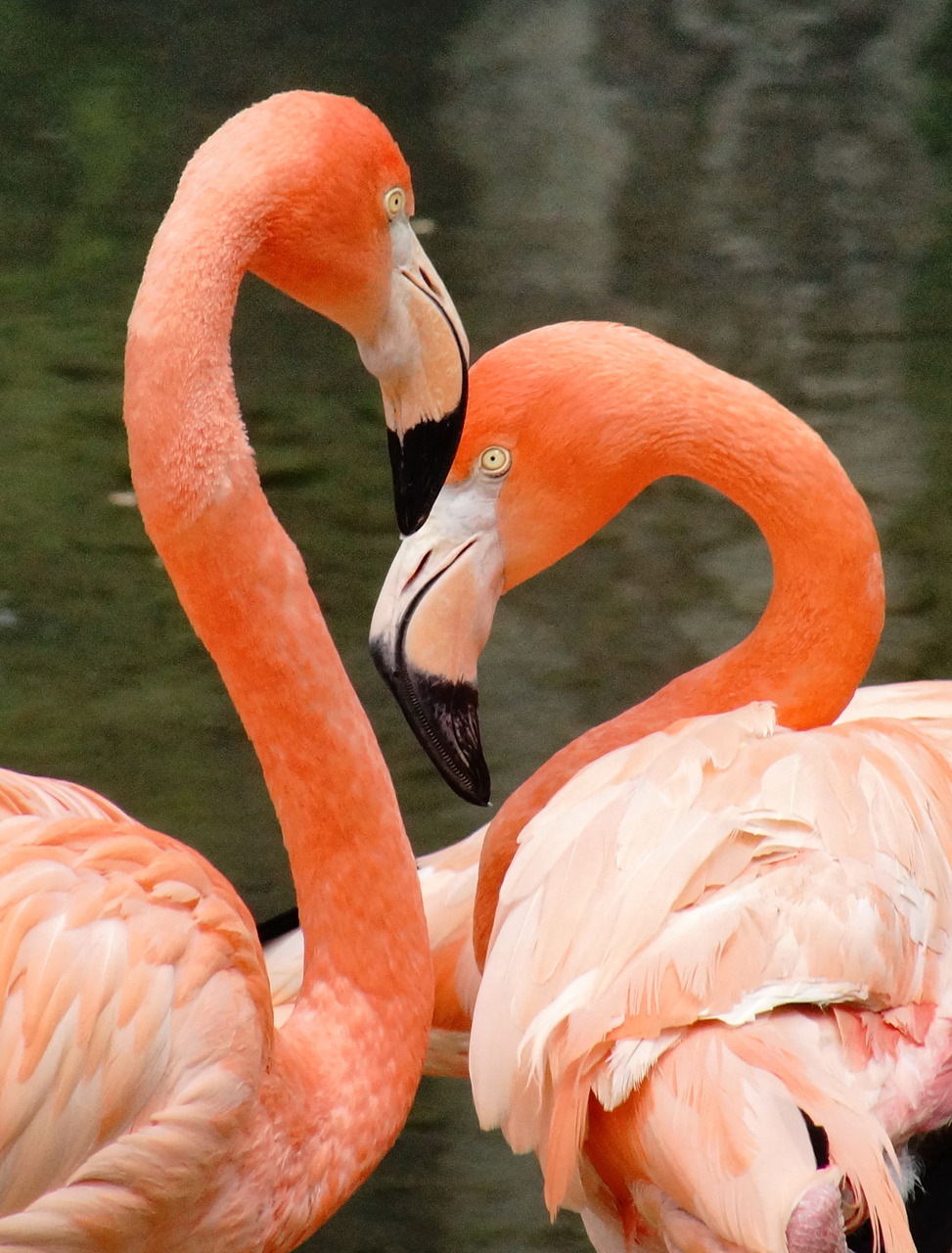
Well, I’ve jumped to the sad subject! However, I do know that 90 per cent of all zoo inhabitants were born from… inhabitants of other zoos. And anyway they feel much better than their siblings, which became the exhibits at zoological museums, or exotic cuisine foods. It’s a matter far from safe — to live with a human on the same planet.
Actually, our Almaty zoo that was founded back in the symbolic 1937 was always a peculiar touchstone of humanist attitude towards animals in the Soviet Union. It continues to improve itself in order to be up to its status. That is why, regardless of their level of humanity, our citizens keep on visiting the zoo with their kids as soon as they become toddlers.
How the Academy of Sciences of Kazakhstan was built
Few people know that the temple of Kazakhstan science was designed by the famous Soviet architect A.V. Shchusev, who designed Lenin’s mausoleum as well.
Designing of the Academy of Sciences of the Kazakh SSR started a year later after the war. K.I. Satpayev, the first President of the Academy, in his first report said: “According to the personal instructions of Comrade Stalin, preparation of the construction of the main building of the Academy of Sciences of the Kazakh SSR is in progress, it will be a monumental building in the capital of Kazakhstan — Alma-Ata. Construction of the main building of the Academy will be completed in the fourth five-year period.”
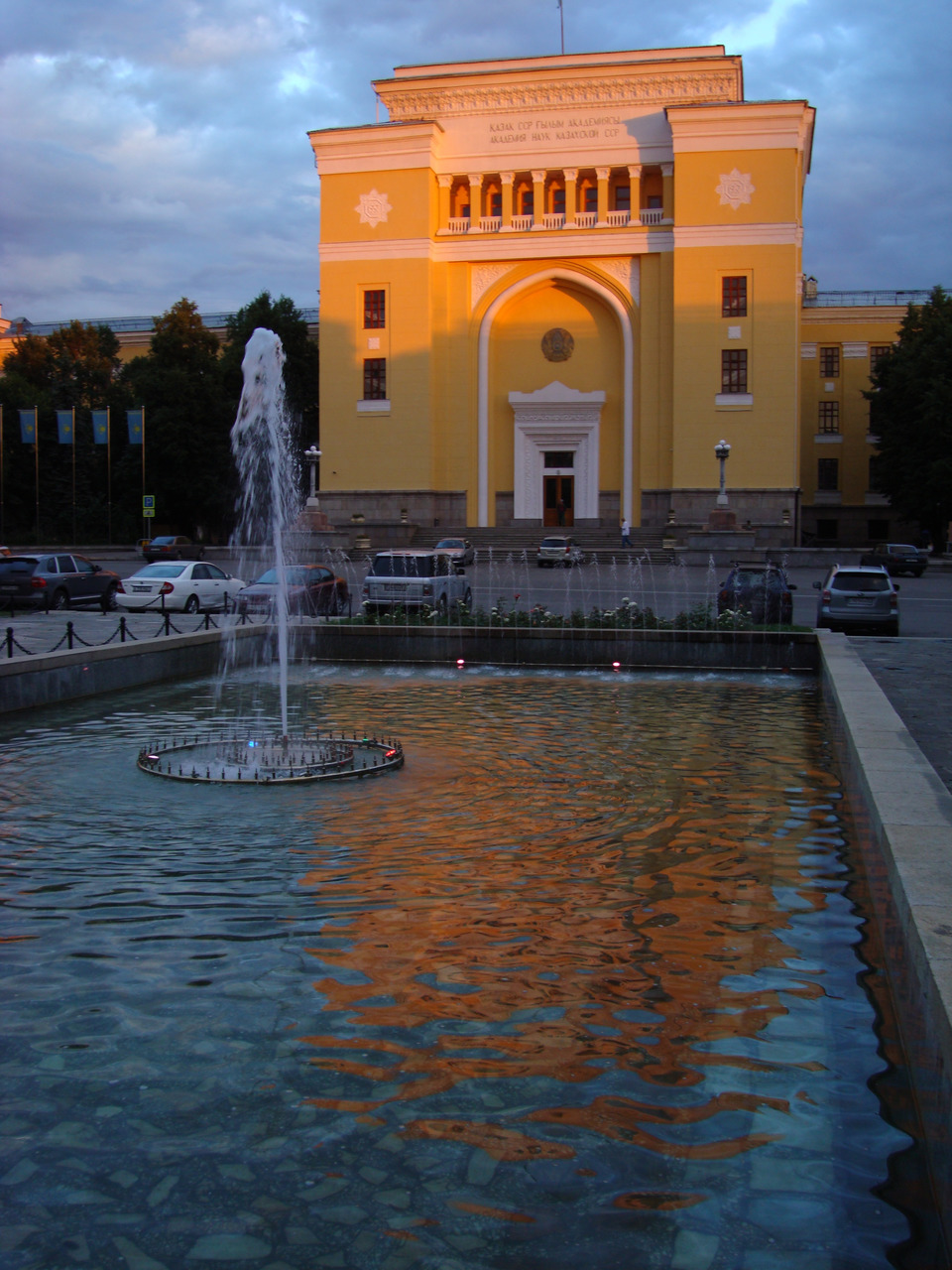
Two years later, Moscow masters- academician Shchusev, the Stalin prize laureate and author of the Lenin’s tomb, and the architect Prostakov made two designs for this project. First one you can see on the picture, and the second you can see in reality.
The stamp “the courtier architect of Stalin” and builder of Lenin’s Mausoleum suppressed all other architectural projects and achievements of Alexei Viktorovich Shchusev. Meanwhile, he had a certain reputation even before Russia became a “country of the Bolsheviks”. Take at least, well-known to all Kazakhstan senior generation, Kazansky railway station in Moscow, construction of which began in 1914.
But, admittedly, Shchusev showed what he could do only under the new government. During the first decade, he built not only a mausoleum, but also he was the director of the Tretyakov Gallery, took care of the first Soviet reconstruction plan of Moscow (after which only fragments remained from the old Moscow); he was one of the apologists of Soviet Constructivism (hotel “Moscow” was his brainchild).
Architect — academician made his contribution to the “development of national architecture of sister republics”. Many people saw his beautiful creation in Tashkent — Big Opera and Ballet Theatre. Large place in his postwar biography takes rebuilding of the destroyed cities: Istria, Novgorod and Chisinau. As for our Academy, Shchusev did not see his offspring — he died in 1949…
Why was rejected the first design? The answer was given in the book “Architecture of Alma-Ata” by M. Mendekulov, venerable Kazakhstani architect. The reasons were:
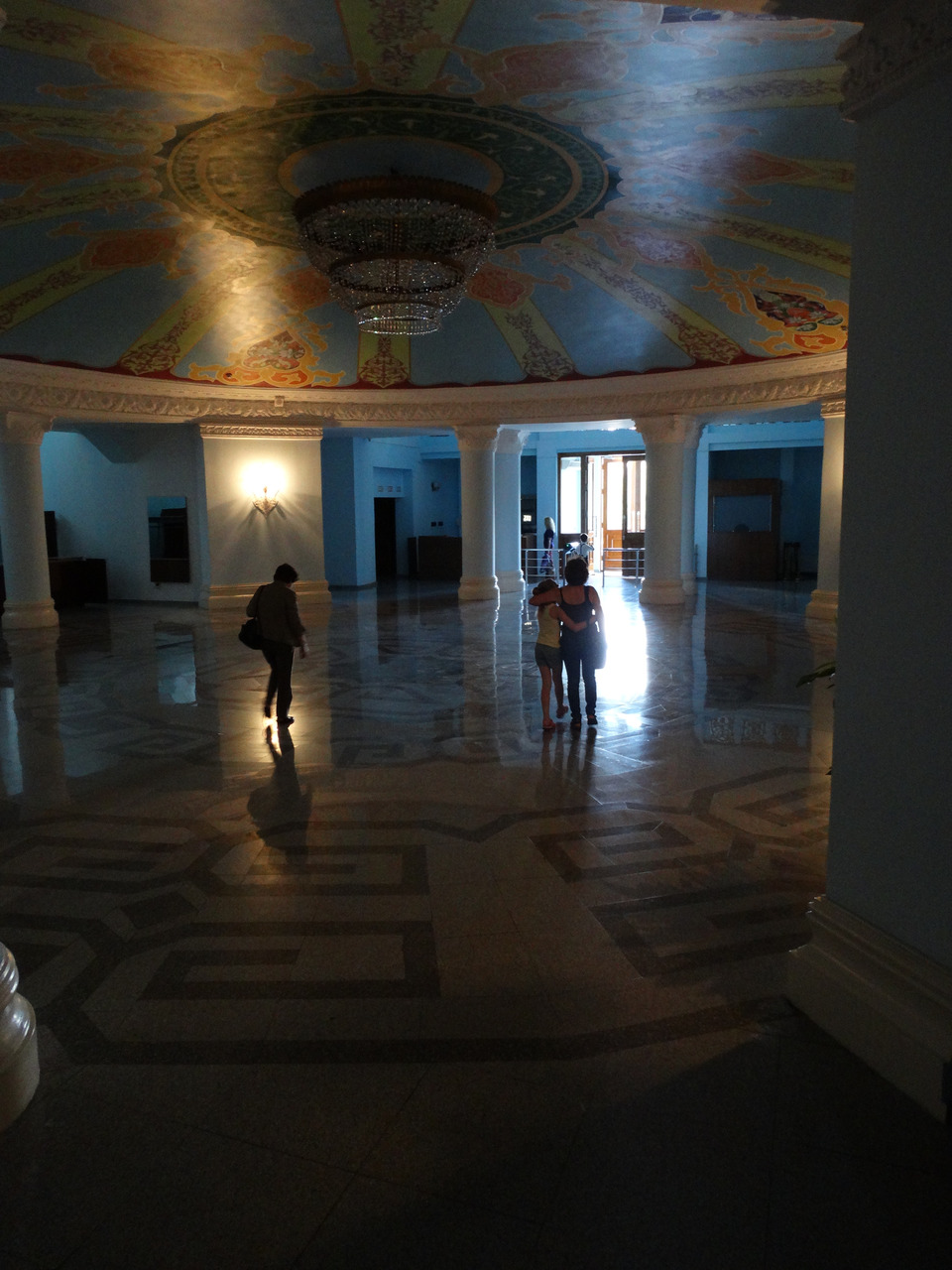
“First, the building had not clearly identified image of the Soviet scientific institution, it had some features of cult building from the past; main facade had massive solid portals and bulky spherical cupola, it resembled madrasas (spiritual schools). And secondly, the decoration of the building had not a national Kazakh ornament, making it look impersonally”.
Construction started by the second design in 1951. From this project were removed not only the “cult” elements, which so irritated officials, but also the co-author of the famous builder of the mausoleum.
Popular memories, that building was built by the Japanese prisoners of war, must be treated with caution; or rather, treat them as memories should be treated. Japanese builders are urban myth number 2 (the first one is about Trotsky). Therefore, if you believe in all such memories, then turns out that the whole old Alma- Ata was built by the valiant Japanese (and every other citizen at least once in their life have seen Leo Trotsky in the Ile reeds). I saw “Japanese track” even where the construction was completed before the Soviet Union entered the war against Japan.
Despite the plan, Presidium Building was not ready during the fourth five-year plan and in the fifth as well. Construction ended only in 1957 (and this was the sixth five-year plan!); but it was finished only from the front side, the back side was built a quarter century later.

Few people know, that the Schusev and Prostakov project included not only the building of the Presidium, but the whole complex of the Academy of Sciences, that supposed to start at the main doors on Shevchenko street and end at the beautiful semicircular area on Kalinin Street (in the diagram). Interestingly, but the boulevard itself (now — street Valikhanova) was preserved to a certain extent; it cannot be said about the other part of the complex, which supposed to include institutions buildings and houses in the middle of parks and fountains. Only square in front of the Presidium was finished, but by other projects.
Despite the pomposity of the building, it became home for many generations of Alma-Ata inhabitants. Many people who are far from science, visited museums (inside the Academy) as children, many students attended the academic library, but most just walked around the Academy — no wonder that this place is considered as one of the most favorite among the citizens.
Kok Tobe, the sightseeing platform in Alma-Ata
To get a detailed view of the largest megalopolis in the country from above, you have neither to order a helicopter nor to search for the entrance to the roofs of the highest skyscrapers at all. To take a cable car at Abay square will be enough. Within ten minutes of ride you’ll see our southern capital under your feet and stretched out right in front of your eyes!
Kok Tobe is 1070 m high. This is above sea level. But because Almaty at the foot of Zailiyskiy Alatau is located 700—800 m above sea level, our sightseeing platform happens to sit just at the point from which you’ll be able to see not only the whole city, but spot all the smallest details in it. In main streets one can observe not only cars, but pedestrians, too. If you have good eyesight, you may tell a woman from a man (it’s not Europe that we live in!). And, moreover, to assess how pretty the woman is (provided you have fertile imagination).
The best time for viewing the city from above is the early Sunday morning in summer. After the night rain. But the most vivid impression is that you get from the view of the evening city, when sun is setting in distant steppes, shadows outline more and more details of the urban landscape, light is going off and the shining night illumination is on below.
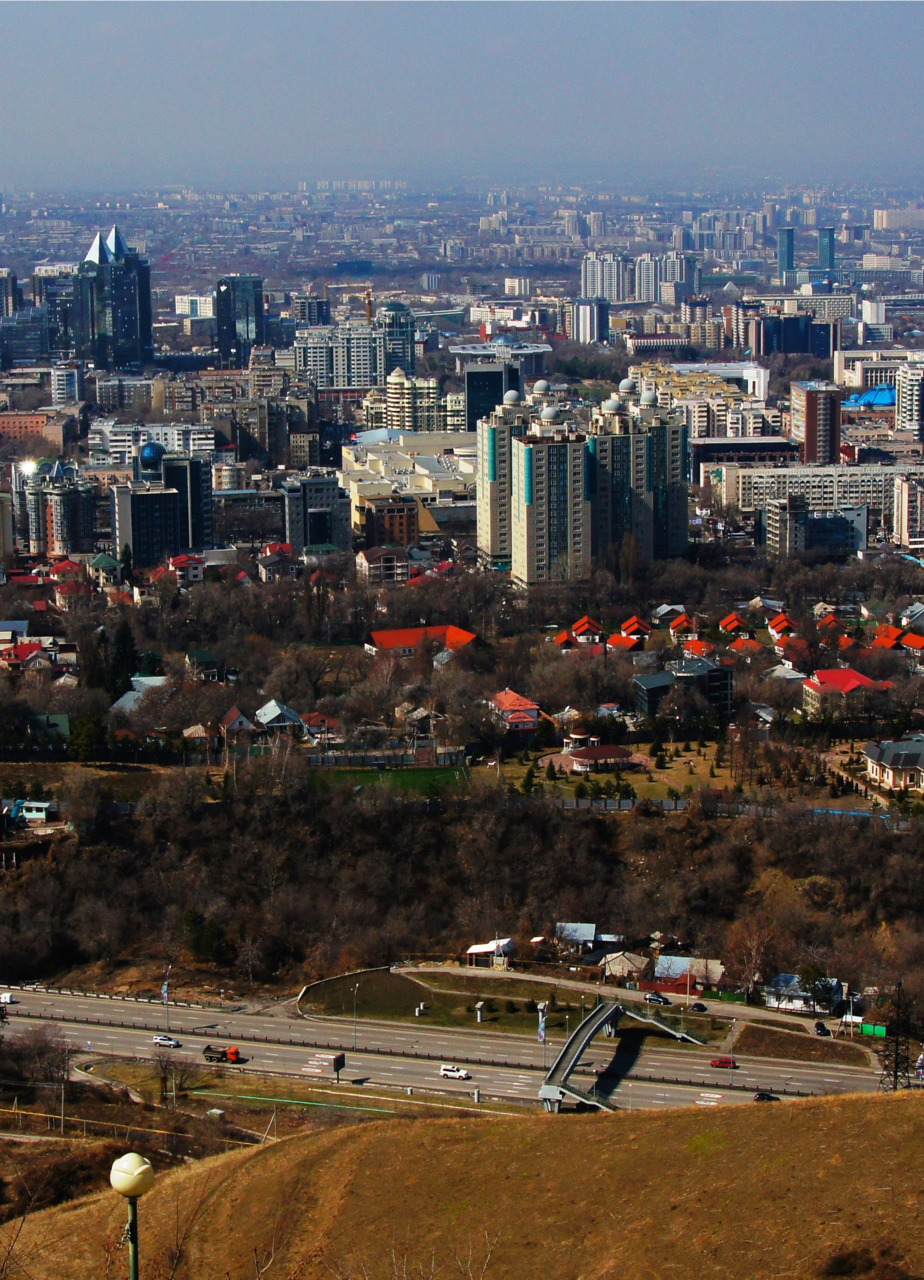
However, you may look other directions from Kok Tobe. The mountain view from here is not less breathtaking than view of the city!
Museum of steppe sounds
In the historical downtown of Alma-Ata, in one of the last scraps of the old Vernyi city — the former House of Officers, there is one of the most curious museums of Kazakhstan. It is the museum of musical instruments. Everything that ever sounded in the Great Steppe and pleased the ear of its inhabitants is lovingly collected here.
It is interesting that musical instruments of Kazakhs were made from materials, which were taken straight from the nature surrounding them. And craftsmen who created these instruments were renowned as much as performers. As for performers, in the steppe hierarchy they were also close by khans and sultans!
Бесплатный фрагмент закончился.
Купите книгу, чтобы продолжить чтение.
